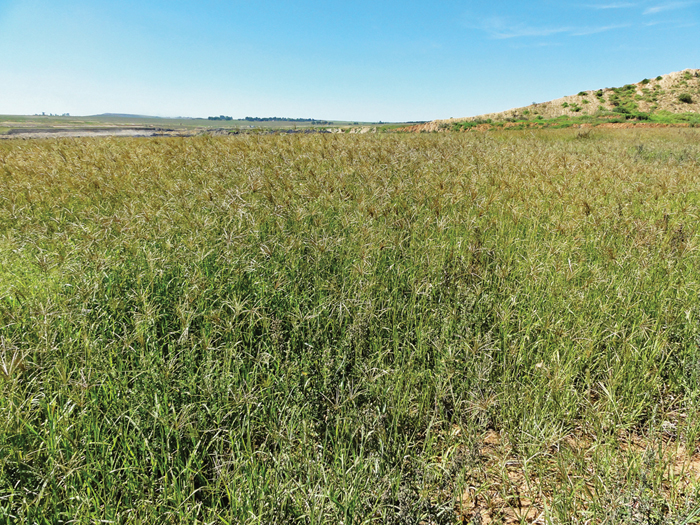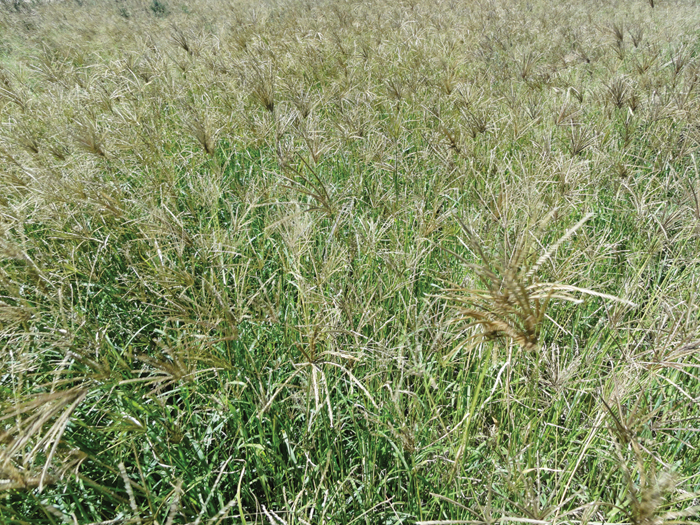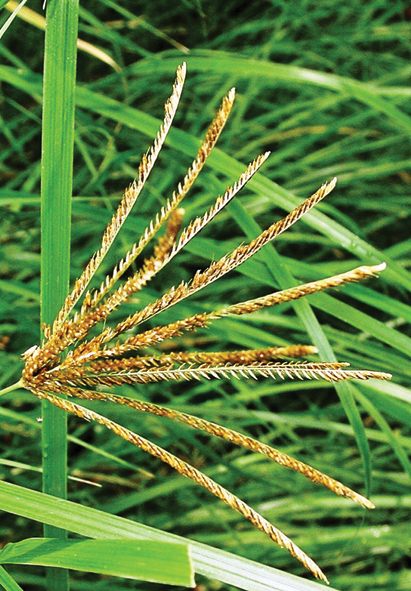Category: CONSERVATION AGRICULTURE
 |
This article is the fourth in a series of articles highlighting a specific pasture crop species that can play an imperative role in conservation agriculture (CA) based crop-pasture-rotations. Besides improving the physical, chemical, hydrological and biological properties of the soil, such species, including annual or perennial cover crops, can successfully be used as animal feed.
Livestock production systems are in many ways dependant on the utilisation of pasture species, in this case as a pasture ley crop, and can therefore become an integral component of CA-based crop-pasture rotations. It is imperative however to identify a pasture species fulfilling the requirements of a dual purpose crop, i.e. for livestock fodder and soil restoration.
According to literature, Rhodes grass was imported to South Africa in 1895. An information document by the Food and Agriculture Organization of the United Nations (FAO), published on the internet, reads: “Katambora Rhodes grass originating from the banks of the Zambesi River, in Zimbabwe”.
Katambora Rhodes grass is one of the most popular cultivars of this species and its seed was produced for many years by tobacco farmers in Zimbabwe. At this moment, Katambora and Boma are the only two cultivars on the South African cultivar list, although the cultivar, Giant (originally from Tanzania), is also used in Southern Africa.
As the name indicates, Giant is a tall grower and high yielding grass, but not palatable at a matured growth stage and less drought resistant than the other cultivars.

Field of Rhodes grass in its first year reproductive stage. |
One of the reasons for Rhodes grass’s popularity is its ability to adapt to a variety of climatic and soil conditions. In general, it is suggested that it be planted in areas with a rainfall of 650 mm/annum and higher.
Although it grows well in wetter swamp areas with soils of higher clay content, it also grows well in the dryer areas of the Limpopo province. It is well-known for its ability to grow in soil with a high pH and even brackish soil. It can survive low temperatures and even frost.
Rhodes grass is known to be a weak perennial species and can be very productive for three to four years, but since it has a high seed production and if left to reseed itself before defoliating it, you can extend this period slightly.

Rhodes grass production at 16 tons DM/ha. |
Because of its woolly/fluffy seeds it should be established in a well-prepared, fine and firm seedbed. Proper rolling before and after seeding will benefit germination and establishment. Establishment can be done with pure Rhodes grass seed, at 5 kg/ha to 8 kg/ha in rows and 8 kg/ha to 12 kg/ha broadcasted.
When using coated seed, the seeding rate should be increased by at least 30%. This species germinates and establishes quicker than other strong perennial species and is therefore always recommended to be planted in a mixture.
The following mixtures could be considered:
When better moisture conservation is a requirement in dry seasons, it is advisable that species are planted in rows. The rows should be approximately 600 mm to 900 mm from each other and it should be consolidated properly to facilitate good germination. The tractor wheel or compression wheel planter method has proven to be a reputable method to achieve this purpose. In areas with higher rainfall broadcast seeding (more seed per hectare), it is recommended with the requirement of sufficient consolidation through rolling.

The inflorescence of Rhodes grass. |
It is important that each and every planted pasture should be fertilised for long-term sustainable production. Rhodes grass will grow in soil with a pH of 6 to 7, but also grows well in higher pH and brackish conditions.
The phosphorus (P) content of the soil should be 12 mg/kg - 18 mg/kg before establishment, while the potassium (K) content should be between 100 mg/kg and 120 mg/kg. It is important to monitor these fertility levels, especially in the case of hay production, where no recycling of dung and urine occur.
An annual application of 60 mg/kg to 150 kg/ha pure N (± 200 mg/kg to 600 kg/ha of limestone ammonium nitrate), depending on rainfall, is suggested. Because of high fertiliser prices, the following procedure can be followed: In low rainfall areas, apply ± 30 kg N/ha (± 100 kg/ha of limestone ammonium nitrate), early summer, after the first 50 mm to 70 mm rain.
After the first cut or grazing cycle, apply 30 kg N/ha again and if there is enough rain in January, a final application of 30 kg N/ha can be applied (total 90 kg N/ha) if deemed necessary. In higher rainfall areas (600 mm +) the same strategy can be followed, but with higher application rates (50 kg to 60 kg N/ha or 170 kg/ha to 200 kg/ha limestone ammonium nitrate).
Because of Rhodes grass’s inherent palatability, it can be used in a fodder flow programme for an entire year. Besides being used for grazing, Rhodes grass makes excellent hay and is regarded a good foggage (staande hooi) option in winter.
To be employed as a foggage, the grass should be utilised early in summer as grazing or hay and then be rested from mid-January until the beginning of winter. Fertilisation in January is then of utmost importance.
If over utilised, Rhodes grass tends to die out at an early stage. It is speculated that its growth points are situated higher above the soil level than other grasses and are therefore easily damaged by short grazing.
A second theory is that the grass stores its energy reserves during winter in the root crowns as well as the base of the plant (above soil level) and that short spring grazing can be detrimental. The fact that a sward of Rhodes grass in the Free State survived for 17 years because it was only cut for hay and not grazed, might support the abovementioned theories.
Because of Rhodes grass’s ability to spread by stolons or runners, it is a good species to be used for erosion control. Rhodes grass also has a further advantage through its ability to control Nematodes (eelworm). Both these characteristics make it a useful rotational crop for tobacco, tomato, potato and pineapple farmers.
The most important characteristics of Rhodes grass are:
These characteristics make it a very useful and an “all-rounder” pasture.
Research has shown that grazing capacities of up to 2 LSU/ha can be achieved with a total weight gain of 0,6 kg/LSU/day, with a total mass of 448 kg/ha. In extremely high rainfall seasons it can be expected to achieve 23 tons/ha hay production.
The nutritional value of Rhodes grass is highly dependent on climatic factors, soil fertility and fertilisation. The crude protein content of young growth can vary between 15% - 17%, and can however be as low as 4% if the pasture is very mature with old stems.
After establishing a typical ley crop system using Rhodes grass for a period of around five years, the soil should be sufficiently restored to cultivate annual grain crops under a CA system. Herbicides kill the pasture quickly and the pasture residues remain on the soil surface providing cover that limits erosion, enhance water infiltration and reduces their rate of mineralisation.
Once a decision is made to terminate the ley, all pasture components should be considered as “weeds” that need to be removed. They should no longer be regarded as a source of fodder for livestock.
Depending on the pasture species and situation (e.g. dry or wet area), the pasture could be killed a season before planting grain crops to allow the soil profile to be replenished with water. The water requirement of the first crop planned after pasture will influence the timing of removal of the pasture. Reliable and timely seasonal rainfall forecasts may assist in this planning.
Following the pasture phase, grain crop yield will be restricted unless the soil water profile is replenished. After removing the pasture, weeds in the fallow must be controlled to conserve soil water to maximise the benefit of the ley. A suitable no-till planter should be used to plant the grain crops directly into the residues of the pasture crop, without any other cultivation practice disturbing the soil. Normal integrated fertiliser (based on soil fertility levels and yield targets), weed and pest control practices should be followed.
Rhodes grass is a grass that comes highly recommended. It is regarded to have many functions within a crop and livestock production system. Not only does it provide good quality hay and grazing when it is used as pasture in a ley cropping system, it serves as a fumigant for soils infested with nematodes for example.
This grass establishes itself quickly and has the ability to stabilise degraded and/or vulnerable soils with a high erosion potential, protecting soils from being destabilised by overgrazing. As with many pastures, if high quality pasture is required, responsible fertilisation at appropriate times is essential.
For more information, contact Dr Wayne Truter at wayne.truter@up.ac.za, Prof Chris Dannhauser at admin@GrassSA.co.za, Dr Hendrik Smith at hendrik.smith@grainsa.co.za or Mr Gerrie Trytsman at gtrytsman@arc.agric.za.